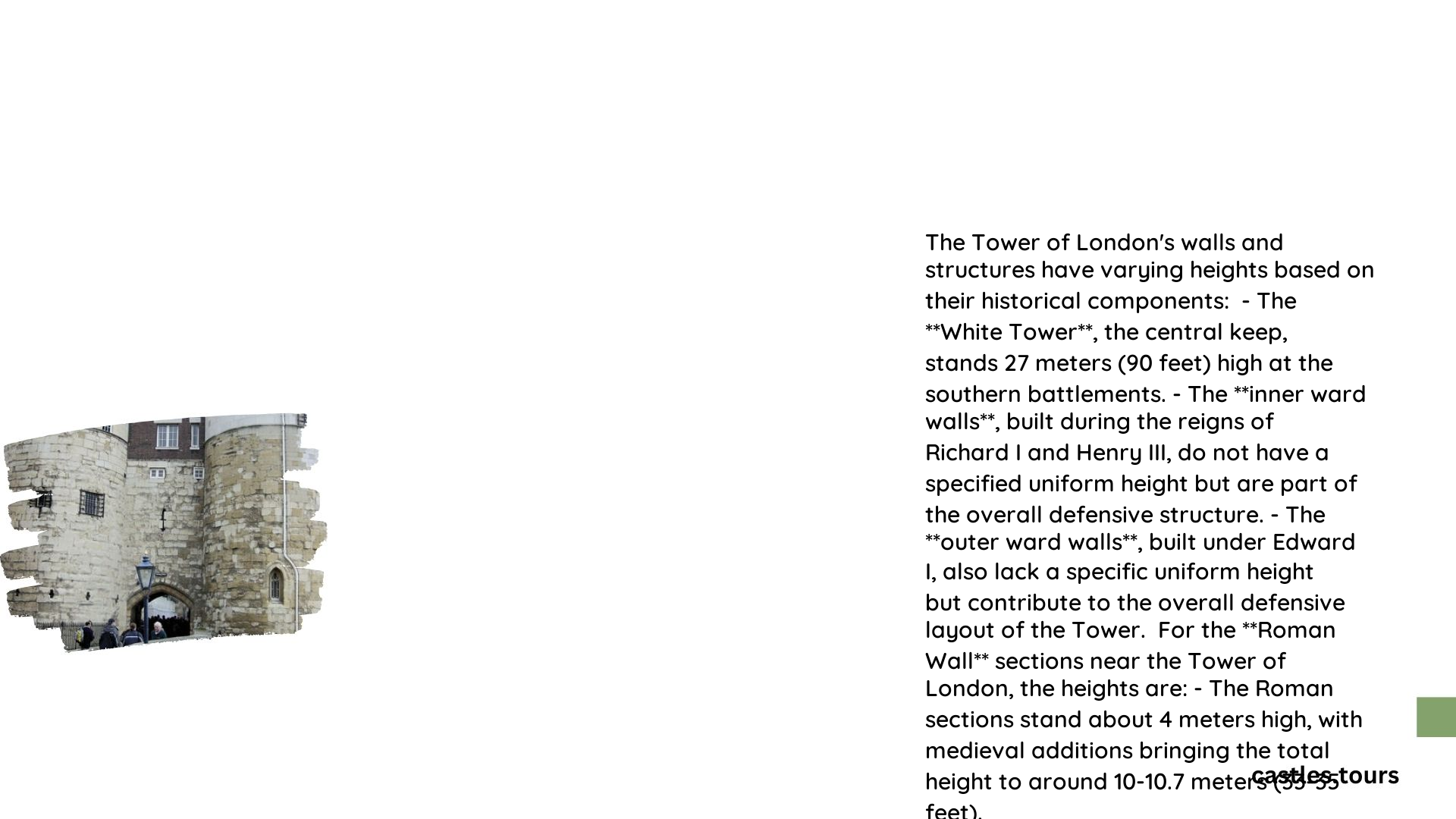The Tower of London, a historic castle and fortress in central London, is renowned for its imposing walls and defensive structures. The walls of the Tower of London vary in height, with the White Tower standing at 27 meters (90 feet) tall at its southern battlements. The outer walls form a perimeter measuring 210 meters in width and 240 meters in length, enclosing an area of approximately 4.9 hectares (12 acres). These walls, primarily constructed of Kentish ragstone, have played a crucial role in the castle’s defense throughout history.
What are the Key Dimensions of the Tower of London Walls?

The Tower of London’s walls are an impressive feat of medieval engineering, encompassing a significant area and providing formidable defense. Here are the key dimensions:
- Total enclosed area: 4.9 hectares (12 acres)
- Outer wall perimeter: 210 meters wide by 240 meters long
- Moat width: 30 meters (general), 10 meters (south side)
- Southern rampart length: 240 meters
These dimensions highlight the scale of the fortress and its defensive capabilities.
How Tall is the White Tower?

The White Tower, the central and oldest part of the Tower of London complex, stands as a testament to Norman architecture and military engineering:
- Height: 27 meters (90 feet) at the southern battlements
- Construction date: 1078
- Wall thickness: 4.6 meters
This imposing structure has dominated the London skyline for nearly a millennium, serving as both a royal residence and a symbol of power.
What Materials Were Used in the Tower’s Wall Construction?
The builders of the Tower of London utilized a variety of materials to create its robust walls:
- Kentish ragstone: Primary building material
- Caen stone: Imported from northern France for detailing (later replaced)
- Portland stone: Used in 17th and 18th-century renovations
- Reigate stone: Employed for ashlar and carved details
The use of these materials contributed to the durability and longevity of the Tower’s walls.
How Do the Tower’s Walls Compare to Other Historical Fortifications?
To understand the significance of the Tower of London’s wall height, it’s helpful to compare it to other historical defensive structures:
| Fortification | Wall Height | Wall Thickness |
|---|---|---|
| Tower of London (White Tower) | 27 meters | 4.6 meters |
| Roman London Wall | Up to 6 meters | 2.5-3 meters |
| Tower of London Outer Ramparts | Varies | 10 meters |
This comparison illustrates that the Tower of London’s walls were exceptionally robust for their time, surpassing many contemporary fortifications in both height and thickness.
What is the Historical Significance of the Tower’s Wall Height?
The height of the Tower of London’s walls played a crucial role in its defensive capabilities and symbolic power:
- Deterrent to invaders: The imposing height made scaling the walls extremely difficult.
- Vantage point: Allowed defenders to spot approaching threats from a distance.
- Symbol of royal authority: The towering walls projected an image of strength and power.
- Adaptability: Over time, the walls were reinforced and expanded to meet evolving military needs.
The walls’ height contributed significantly to the Tower’s reputation as an impregnable fortress throughout much of its history.
How Has the Wall Height Changed Over Time?
The Tower of London’s wall height has evolved over the centuries:
- 1078: Initial construction of the White Tower at 27 meters high
- 12th century: Addition of the inner ward, doubling the castle’s size
- 13th century: Further expansions under Henry III
- 14th-15th centuries: Ongoing reinforcements and modifications
- Modern era: Conservation efforts to maintain the walls’ integrity
Despite these changes, the core structure and impressive height of the walls have remained largely intact, preserving the Tower’s formidable appearance.
What Challenges Does the Wall Height Present for Modern Conservation?
The considerable height of the Tower of London’s walls poses unique challenges for modern conservation efforts:
- Access difficulties for maintenance and repairs
- Weather exposure leading to erosion and degradation
- Structural stress due to the walls’ weight and age
- Balancing historical authenticity with modern safety standards
- Visitor safety considerations while maintaining the walls’ integrity
Conservators must employ specialized techniques and equipment to address these challenges and preserve the walls for future generations.
In conclusion, the Tower of London’s wall height, particularly that of the White Tower at 27 meters, stands as a testament to medieval engineering and continues to captivate visitors with its imposing presence. The walls’ dimensions, materials, and historical significance contribute to the Tower’s status as one of the world’s most renowned fortresses and a symbol of British history.
References:
– https://www.wonders-of-the-world.net/Tower-of-London/Dimensions-of-the-tower-of-London.php
– https://en.wikipedia.org/wiki/Tower_of_london
– https://en.wikipedia.org/wiki/London_Wall
